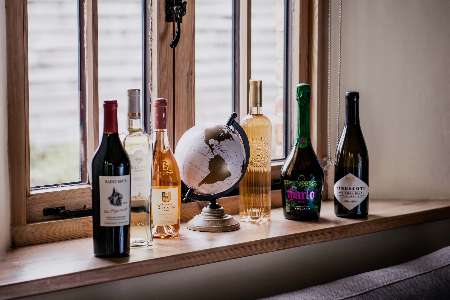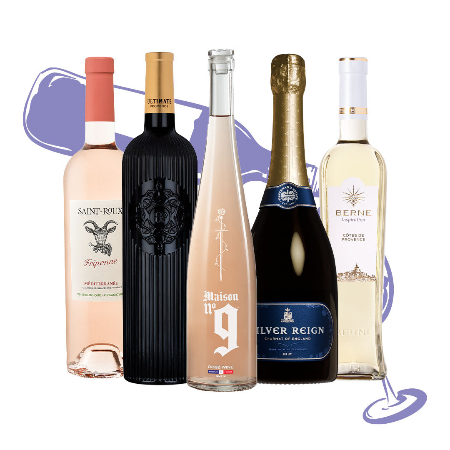Wine, also known as ‘vino’, is an internationally adored alcoholic and intoxicating beverage, usually produced by fermenting grapes.
With a long and illustrious history, Wine is considered to be one of the oldest alcoholic beverages and is said to have been the favourite alcoholic tipple of many of history’s greatest known figures.
Now if you're new to the world of wine (and we’d have to ask where have you been?) you may well be confused by the vast selection of wines available.
However fear not, as despite there being several distinct categories of wine from which you might choose… In this article, I will share 7 different types of wine that you simply need to know.
So, before we start, let's learn more about wine.

What is so unique about wine?
The history of drinking alcohol is no secret and its place in social culture has remained prominent for centuries.
From a healthy lifestyle point of view, the disadvantages of drinking alcohol (certainly regularly) unfortunately far outweigh the benefits.
However, it is still very much a part and parcel of modern life and as many recent medical studies suggest, if Wine is your drink of choice - there could be at least a little light at the end of the tunnel.
The unique thing about wine is that it is proven to stimulate the senses (sight, taste, smell, and touch) in a way that no other alcoholic beverage quite can.
Due to the stimulating effects it has on the brain and indeed the body, most people love to drink wine in social and casual situations, especially exclusive wine, because of the enhanced effects engaged through a use of premium ingredients.
These elements infused with the properties of the alcohol content, causes the brain to release dopamine, inevitably making the drinker cheerful for a sustained period.
Aside from the taste, fragrance, and flavour… the occasion, situation, environment, and people with whom you are enjoying the wine are sure to make each experience memorable and unique for you.
So what varieties of grapes are used to make wine?
The two most common varieties of grapes are red and white grapes. The juice from white grapes has a greenish appearance and unsurprisingly is used to make white wine.
The red grapes, sometimes known as black grapes, have a reddish or purple appearance and are used in the process of making both red and white wine.
Within those 2 simpler categories, are literally hundreds of different grape varieties that are utilised to produce thousands upon thousands of different wine varietals.
Interestingly, there are an impressive 1046 different grape varieties listed on Wikipedia.
These are then organised into two major types of species (Single species grapes - 948 varieties and Multispecies hybrid grapes - 96 varieties). Click here for the list of grape varietals from Wikipedia.
Numerous categories of wine are then subdivided depending on factors including taste, aroma, flavour, fermentation process, used vessel, appearance, climate, grape variety, sweetness, winemaking method, ageing period, region, and so much more.
What are the 7 different types of wine?
Here are the 7 varieties of wine that you really need to be familiar with.

Red Wine
Red wine, a flavoursome favourite, actually obtains its rich colour and taste (particularly tannins) by fermenting with the grape skins.
The majority of purple or red grapes actually produce greenish-white wine (and we promised to make this less confusing?), with the red colour we’ve all come to adore, originating from anthocyanin pigments found in the grape skin.
After indulging in a sip of a truly good red wine, the tannish often leaves a harsh, somewhat dry taste in your mouth, which can often be compared to chocolatey or sometimes oaky
notes.
Red wines are best enjoyed at or just below room temperature, due to the fact that red wine's tannins turn bitter when drunk and more so at this regulated temperature. The more tannins a wine contains, the darker or newer it is. Choose an older wine; it will be less dry and bitter in flavour, however it is worth noting that lighter, more acidic red wines may be considered more delectable when chilled.
Red wine pairing is mostly a matter of personal opinion, but there are a few points to remember when getting started.
Hearty meals like red meat or slow-cooked, rich dishes go well with bold, full-bodied red wines.
Lighter reds go well with a variety of foods, including pizza, pasta, and even chicken.
Lighter-bodied reds have more acidity, less tannin, lower alcohol content, and red fruit flavours.
Medium-bodied red wines have a combination of red and dark fruit flavours, moderate alcohol content, and light tannins.
Full-bodied red wines have greater alcohol content, robust tannins, and black fruit and peppery characteristics (possibly some of the key reasons these are considered best enjoyed with rich meats).
Red wine grape varieties include Pinot noir, Cabernet Sauvignon, Malbec, Tempranillo, Merlot, Bobal, Cinsaut & Zinfandel.
White Wine
According to Wikipedia, white wine is believed to have been around for over an impressive 4,000 years… and if that’s not testament to the quality of a drink, i’m not sure what else is.
It can be produced using both black and white grapes as discussed above, but much like red wine - the variety of grapes and the fermentation process used will heavily dictate the body of flavour given to the end product.
Important to note; one key difference between Red wine and White wine, is that White wine is not fermented with grape skins, but instead just the inner pulp of the grape itself.
White wine is made by pressing grapes swiftly and removing the liquid from the grape skins with speed, meaning that the final product of White wine has little tannins; and its acidity gives it fresh, crisp flavours.
White wine tastes better when chilled and its ideal temperature is thought to be between 49 - 55 degrees Fahrenheit.
A full-bodied white wine has a creamier and stronger taste that is often aged in oak. A light-bodied
white wine is crisp and acidic and can also taste anything from citrusy to herbaceous.
White wine is best paired with lighter fare like chicken, fish, or shellfish - however popular culture has taught us that it also compliments a number of snacks and dishes such as popcorn, cheeses, curries, tacos, salads, and chips.
White wine grape varieties include Chardonnay, Sauvignon blanc, Muscat, Müller-Thurgau, Chenin blanc, Trebbiano, Viognier, Sauvignon gris, Pinot Meunier, Grenache Gris and more.
Rosé wine
Rosé wine, often a little sweeter than both red or white, may be best recognised by its uniquely blush-pink hue.
Black grape skins are what give rosé wine its distinctive colour, but not enough to classify it as a red wine.
After a short period of time, the grape skins are peeled off and discarded. Skin contact (allowing the wort to get stained by black grape skins), saignée (separating the juice from the grape early in the fermentation process and allowing the juice to finish fermenting on its own), and combining red and white wines are the three main methods for making rosé wine (though the latter is considered unusual and discouraged in the majority of wine-producing regions).
Any kind of black grape may be used to make rosé wine, and both the location and grape variety used will naturally affect the wine's final flavour.
Though some rosés can be considered quite dry, they also contain very little tannin. Rosé pairs well with lighter foods and snacks like fruit, chips, salsas, creamier cheeses, fish, chicken, and .
The most well-known rose wines are Provence (French), Rosado (Spanish), and Rosato (Italian).
Orange Wine
Orange wine, often also referred to as ‘Amber wine’, can be anything from dark gold to pale straw in colour, somewhat rendering the name “orange” a little misleading.
Though made in a very similar way to both red and rosé wine… the white grapes are used to make these wines, but the skins are left to soak while pressing.
This process and the prolonged soaking of the skins, give Orange wine a distinct tannic flavour and are generally prepared dry.
Orange wine pairs well with both heartier dishes like chicken, pork or beef based recipes, as well as lighter dishes in many cases such as fish or vegetarian cuisine. In comparison to white wines, orange wines are often served a little warmer.
Sparkling Wine
The location of origin for sparkling wines is often (if not always) reflected in their names. Sparkling wine is fermented in a bottle to create CO2 bubbles that cause the wine to become effervescent and give it a light, sparkling character.
Sparkling wines are sugared and flavoured, most often using white wines, however it’s not uncommon to find sparkling rosé wine and on occasion sparkling red wines too.
Light dishes like shrimp, salads, soft shellfish, lighter cheeses, smoked salmon, fresh fruit, and crisps are recommended as food pairings. Always serve sparkling wine chilled.
English sparkling wine, Champagne (fine sparkling wine from the Champagne region of France), Cava (sparkling wine from Spain), Prosecco (sparkling wine from Italy), Lambrusco, sparkling rose & pink champagne are just a few well known examples of sparkling wines.
Fortified Wine
The addition of distilled alcohol, most often brandy, to wine - results in the production of a wine known as fortified wine.
Typically quite rich in sugar and alcohol content, these wines are traditionally offered towards the conclusion of a meal.
Port, Commandaria, Sherry, Madeira, Marsala, and the aromatized wine vermouth are only a few examples of commonly known fortified wines.
Fortified wine is considered to pair nicely with baked tarts, baked cheeses, almonds, chocolate, and other sweet dishes.
While certain fortified wines, like port, may be served closer to room temperature, others, like sherry, should be slightly chilled and whether these are red or white will often make a difference.
Dessert Wine
In the UK, dessert wines can also be referred to as “pudding wines” and just to avoid any possible confusion, yes these are sweet wines that are usually served with dessert.
Due to the fact that they’re both on the sweeter side, dessert wines and fortified wines are often mixed.
Dessert wine is made from several grape varieties, including Muscat, Ortega, Huxelrebe, etc. Such grape varieties generate much more sugar by nature than many others, making them perfect for their use in Dessert wines.
However, further alcohol and sugar are also added manually in the process of dessert wine making. Some popular dessert wines include raisin wine, ice wine, and noble rot.
Typically, the premise behind a dessert wine is that the wine itself is sweeter than the dish it is served with.
Red dessert wines are often served closer to room temperature, whereas white dessert wines are best served well chilled.
So there we have it, our overview of the must know wines - their individual differentials and all that makes them, well frankly… delicious.
We’ll be taking a look at some of these categories in greater detail over the coming weeks so keep your eyes peeled and if you’re a fan of UK wine or French wine, be sure to give us a follow on social media to see the latest in our collection of exclusive wines.

















